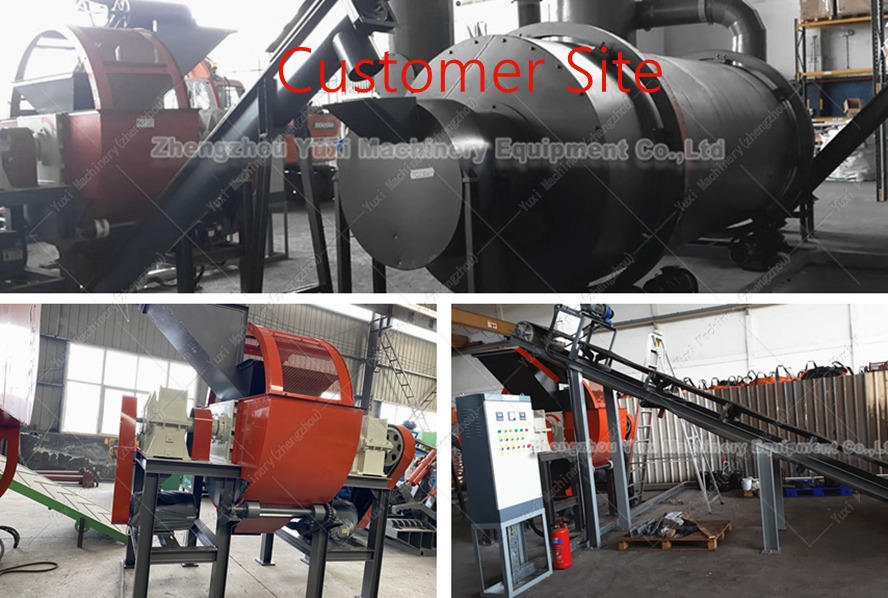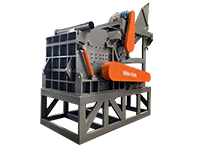Description: Analyze the principles of drum, disc, and mobile wood chippers. Combined with case studies from biomass power plants, furniture factories, and landscaping projects, this guide details selection, maintenance, and efficiency optimization to support resource recycling.
I. Wood Chippers: Technical Principles & Scenario Adaptation of Core Models
Wood chippers convert bulky materials (logs, branches, waste boards) into uniform 30–80mm chips through a synergistic mechanism of shearing, impact, and grinding. They are core equipment for resource recycling in forestry, environmental protection, and energy sectors. The technical characteristics of different models directly determine their applicable scenarios:
1. Drum Chippers: Industrial-Grade High-Capacity Processing
• Core Structure: Rotating drum equipped with 3–4 special alloy flying blades (e.g., Model LDBX-218), operating at 1800–2200 rpm, with a chain-plate intelligent feeding system.
• Technical Advantages: Processing capacity up to 8–15 tons/hour, volume reduction ratio of 15:1, capable of handling hardwoods (e.g., oak, teak) up to 30cm in diameter.
• Applicable Scenarios: Biomass power plants, paper mills, large wood processing plants (daily throughput ≥50 tons).
2. Disc Chippers: Precision Sizing Processing
• Core Structure: Fixed disc blades with adjustable gaps (0.5–50mm), paired with a variable-frequency feeding system.
• Technical Advantages: Chip size accuracy controlled within ±2mm, suitable for producing standard-specification biomass pellet raw materials.
• Applicable Scenarios: Furniture factory scrap recycling, small-scale biomass fuel plants, landscaping (requiring refined chips).
3. Mobile Chippers: Outdoor/Emergency Operations
• Core Structure: Hydraulically driven chassis + foldable hopper (e.g., Jinuo Machinery 50-ton model), equipped with a diesel power system (electric option available).
• Technical Advantages: Off-road performance adapts to mountainous areas and post-disaster sites; on-site processing eliminates transportation links.
• Applicable Scenarios: Forest tending, storm debris disposal, wood recycling in construction waste.

II. Industrial Scenario Case Studies: Efficiency & Cost Empirical Analysis
Case 1: Waste Resource Utilization Upgrade at a Northeast Biomass Power Plant
Project Background: A biomass power plant processed 100,000 tons of straw/wood waste annually using traditional hammer mills, facing three key pain points:
• Low efficiency: Single-unit daily throughput only 120 tons, requiring 8 parallel units.
• High maintenance costs: Bearings/blades replaced twice monthly, with annual maintenance fees exceeding ¥80,000.
• Environmental risks: Excessive dust emissions led to 2 environmental authority warnings.
Upgrade Solution: Replaced with 2 drum-type comprehensive crushers (Model zzjljx, 15 tons/hour) + dust recovery system:
• Efficiency Improvement: Single-unit daily throughput reached 250 tons; 2 units met demand. Volume reduction ratio 15:1 reduced transportation costs from ¥120/ton to ¥36/ton.
• Cost Optimization: Equipment failure rate dropped from 12% to 0.5%, cutting annual maintenance costs to ¥12,000; dust emission concentration <10mg/m³ (compliant with GB13271-2014).
• New Revenue: Processed material calorific value stabilized at 4200 kcal/ton; replacing coal reduced annual CO₂ emissions by ~23,000 tons, generating ~¥560,000/year in carbon trading revenue.
Case 2: Scrap Recycling Production Line at a Guangdong Furniture Factory
Project Background: A custom furniture factory generated 5 tons of sawdust/scraps daily, originally landfilled at ¥350/ton, costing over ¥630,000 annually.
Implementation Plan: Deployed a fully automated production line (disc chipper: 2 tons/hour + biomass pellet mill: 1.5 tons/hour):
• Resource Conversion: Sawdust processed into 4000 kcal biomass pellets, sold at ¥200/ton, generating ~¥360,000/year in sales.
• Efficiency Optimization: Unmanned crushing-pelletizing process reduced labor from 8 workers/shift to 2, saving ~¥480,000/year in labor costs.
• Policy Benefits: Qualified for "industrial solid waste resource utilization" policies, receiving ¥120,000/year in local environmental subsidies.
Case 3: Green Waste Disposal for Chengdu Municipal Landscaping
Project Background: A Chengdu district’s municipal landscaping department pruned ~20,000 tons of branches annually, originally incinerated (posing pollution/safety risks).
Implementation Plan: Purchased 3 mobile chippers (5 tons/hour) for on-site operation at parks/roads:
• Environmental Upgrade: Crushed branches used as mulch (moisture retention + weed control) or compost raw materials, eliminating incineration and reducing annual VOC emissions by ~18 tons.
• Cost Reduction: On-site crushing eliminated transportation, cutting processing costs from ¥200/ton to ¥80/ton, saving ~¥2.4 million/year.
• Resource Recycling: Mulch reduced annual landscaping material procurement costs by ~¥300,000; compost products supplied local farms, generating ~¥150,000/year in additional income.
III. Professional Operation & Maintenance Standard System
Standard Operating Procedures (By Model)
Drum Chippers (Industrial-Grade)
1. Pretreatment: Remove metal/stone impurities; cut long materials to ≤1.2m; air-dry wet wood to <30% moisture content.
2. Startup Preparation: Check lubricant level (gearbox oil ≥2/3); idle for 2 minutes to confirm stable blade speed (1800 rpm).
3. Feeding Operation: Feed uniformly via hydraulic rollers; do not exceed 70% of hopper capacity per batch; slow feeding speed to ≤0.5m/min for hardwood.
4. Shutdown Process: Stop feeding first; idle for 3 minutes to clear residual material; clean blade chips and screens after power-off.
Mobile Chippers (Outdoor)
1. Site Preparation: Select hardened ground; deploy support legs (avoid tilting); connect dust removal system.
2. Power Startup: Preheat diesel models for 3 minutes (confirm oil pressure ≥0.3MPa); check voltage stability (380V ±5%) for electric models.
3. Operation Monitoring: Check bearing temperature (≤60°C) every 30 minutes; stop immediately if jamming occurs, clear material before restarting.
Key Maintenance Nodes & Standards
| Maintenance Cycle | Inspection Item | Standard Requirement |
| Daily | Blade chip cleaning | No residual material |
| Daily | Bearing temperature | ≤60°C |
| Weekly | Blade bolt tightening | Torque ≥80N·m |
| Weekly | Grease lubrication | Apply lithium grease every 3–4 hours |
| Monthly | Blade wear inspection | Replace if wear >5mm |
| Monthly | Screen condition | Replace/clean if clogging rate >20% |
| Quarterly | Gearbox oil change | Replace with 150# industrial gear oil |
Emergency Troubleshooting
1. Jamming:
◦ Stop immediately and cut power.
◦ Open the cover to clear material between blades/screens; use a crowbar for hard material jams.
◦ Check for blade deformation before restarting; replace if deformed.
2. Uneven Chip Size:
◦ Adjust blade gap to 1.2–1.5x material thickness.
◦ Replace worn blades in pairs (avoid imbalance).
◦ Adjust variable-frequency feeding for uniform flow.
3. Pipe Clogging:
◦ Check elbows (clogging hotspots) after shutdown; blow 50°C hot air for wet material clogs.
◦ Optimize pipe curvature to ≥1.5x diameter; install anti-clog sensors (early warning).

IV. Core Decision-Making Dimensions for Selection & Procurement
1. Throughput Matching
• Select equipment by "daily throughput × 1.2 (redundancy coefficient)"; e.g., 5 tons/day → 6 tons/hour model.
• Prioritize "multiple small units" for industrial scenarios (flexible deployment); "large single units" for outdoor scenarios (reduce transportation).
2. Material Adaptation
• Hardwood/coarse material: Choose drum chippers (strong flying blade shearing).
• Refined needs/small material: Choose disc chippers (high sizing accuracy).
• Outdoor/mobile scenarios: Choose hydraulically driven mobile models (off-road performance).
3. Certification & Compliance
• Prioritize equipment certified to EU CE Mark (safety standard) and GB/T 25684-2010 (wood chipper standard).
• Industrial scenarios require compliance with GB13271-2014 (boiler air pollutant emission standard).
4. Life-Cycle Cost Accounting
• Equipment procurement: 30–40% of total life-cycle cost.
• Operating costs: Electricity/fuel (25%), maintenance (15%), labor (10%).
• Hidden costs: Downtime losses, environmental fines (prioritize high-reliability models).
V. 2025 Industry Trends: Intelligence & Low Carbonization
The global wood chipper market is projected to reach $4.86 billion in 2025, with China accounting for 26% of the market. Key technology upgrade directions include:
1. Intelligent Control Systems: PLC + AI algorithms enable adaptive adjustment of feeding speed/blade rotation; IoT modules monitor equipment status in real time, with 95% fault warning accuracy.
2. Low-Carbon Design: Variable-frequency motors reduce energy consumption by 20%; permanent magnet synchronous motors replace traditional asynchronous motors; HEPA-filtered dust recovery systems achieve PM2.5 emissions <5mg/m³.
3. Modular Upgrades: Quick-release blades/screens cut replacement time from 2 hours to 20 minutes; equipment can be expanded with drying/sorting modules for multi-material scenarios.
4. Remote Operation & Maintenance: Leading enterprises offer "Equipment as a Service (EaaS)" models; remote operation centers enable digital fault diagnosis and spare parts scheduling, with <2-hour response times.
 Shredding Machine
Shredding Machine
 Waste Recycling Line
Waste Recycling Line
 Optional Equipment
Optional Equipment


